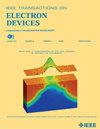深入了解氮化诱导的铁氧体场效应晶体管耐力增强:用非辐射多芬模型表征缺陷特性和动力学
IF 2.9
2区 工程技术
Q2 ENGINEERING, ELECTRICAL & ELECTRONIC
引用次数: 0
摘要
在这项工作中,通过详细分析缺陷的特性和动力学,阐明了氮在提高铁电场效应晶体管(FeFET)耐久性方面的作用。首先,通过非辐射多声子(NMP)模型深入研究了使用 SiO2/SiON 的铁电场效应晶体管的缺陷特性(阱能级 ${E}_{text {T}}$、弛豫能 ${E}_{text {R}}$ 和缺陷密度 ${N}_{text {T}}$)。氮化过程可以显著降低界面层中缺陷的数量和密度。此外,通过比较氮化/非氮化器件在循环过程中界面层和铁电层的缺陷动态,我们发现氮化过程降低了缺陷的电荷转移率和存储器窗口(MW)降解途径的数量。我们还揭示了氮化过程的基本机制,该机制可以解释耐久性的提高。这些发现加深了人们对 FeFET 器件可靠性问题的理解,为提高 FeFET 的性能铺平了道路。本文章由计算机程序翻译,如有差异,请以英文原文为准。
In-Depth Understanding of Nitridation-Induced Endurance Enhancement in FeFETs: Defect Properties and Dynamics Characterized by Nonradiative Multi-Phonon Model
In this work, by analyzing the properties and dynamics of defects in detail, the role of nitrogen in improving the endurance of ferroelectric field-effect transistors (FeFETs) is clarified. First, the properties of defects (trap energy level
${E}_{\text {T}}$
, relaxation energy
${E}_{\text {R}}$
, and defect density
${N}_{\text {T}}$
) of FeFETs with SiO2/SiON are investigated in depth through nonradiative multi-phonon (NMP) model. The nitridation process can significantly decrease the population and density of defects in the interfacial layer. Moreover, by comparing the defect dynamics in the interfacial and ferroelectric layers of nitridation/nonnitridation devices during cycling, we find that the nitridation process reduces the charge transition rate of defects and the number of memory window (MW) degradation pathways. The underlying mechanism of the nitridation process that can explain the increase in endurance is revealed. These findings enhance the understanding of reliability concerns in FeFET devices, paving the way for improving the performance of FeFETs.
求助全文
通过发布文献求助,成功后即可免费获取论文全文。
去求助
来源期刊

IEEE Transactions on Electron Devices
工程技术-工程:电子与电气
CiteScore
5.80
自引率
16.10%
发文量
937
审稿时长
3.8 months
期刊介绍:
IEEE Transactions on Electron Devices publishes original and significant contributions relating to the theory, modeling, design, performance and reliability of electron and ion integrated circuit devices and interconnects, involving insulators, metals, organic materials, micro-plasmas, semiconductors, quantum-effect structures, vacuum devices, and emerging materials with applications in bioelectronics, biomedical electronics, computation, communications, displays, microelectromechanics, imaging, micro-actuators, nanoelectronics, optoelectronics, photovoltaics, power ICs and micro-sensors. Tutorial and review papers on these subjects are also published and occasional special issues appear to present a collection of papers which treat particular areas in more depth and breadth.
 求助内容:
求助内容: 应助结果提醒方式:
应助结果提醒方式:


